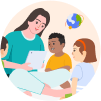Learning and applying Preschool Learning Foundations and Assessment Data
As a childcare provider and teacher, I have learned how to successfully implement the CA Preschool Foundation and assess learning using tools like the DRDP to help children grow and develop their potential. This knowledge has come in the form of formal schooling, coaching through the Central Valley Children’s Network and the Fresno County Early Star Program. Having the support to implement measures that increase the quality of my program management helps me be competent, organized and plan meaningful activities proficiently using the TK model. As a site supervisor and teacher, these available resources and assistance ensure effective operations and a continuous well-run high-quality purposeful program responsive to all participant’s needs.
Using observations tools are a fundamental part in the management of my program. At my facility, I implement the Desired Results Developmental Profile (DRDP) for infants and toddlers. The first steps in completing the DRDPs are observing, recording observations, and collecting documentation such as samples of children’s work. Writing the observations is crucial, they need to be accurate and objective in order to be useful and represent the child appropriately. My observations written for the DRDPs are brief yet detailed, tell a factual ongoing story about the child and state who, what, where, when, and how. The second part of the DRDP consist of in rating the development of each child according to the skills he has mastered using the DRDP measures in the eight domains of development. To finalize the assessment, the rating is entered for all the measures and the information in each page is checked for accuracy. DRPD are the perfect tool because it assesses each child individually and together with the Learning Preschool Foundations, they enhance each child’s learning through playful and fun activities. As Deborah Stipek early education expert mentioned in the Young Children publication, these learning methods of accountability have value, “but we must make sure they do not get in the way of child- centered, developmentally appropriate, playful learning” (Stipek, 2017).
In my program, these methods that are part of the TK model have helped foster the learning and development of young children and prepare them for kindergartner, all while measuring their progress, helping them gain confidence and turning their weaknesses into strengths. Personally, I have seen the importance of implementing learning that inspires and interest children in a play-based environment that incorporates exploration and engagement. This type of learning is best fulfilled using the California Preschool Learning Foundations which serves as a step-by-step guide on providing age-appropriate learning experiences that can be adapted to children of all abilities. In my program, children benefit greatly from the curriculum we have created inspired by the Reggio Emilia approach and organized using the California Preschool Learning Foundations which guides us in supporting all young children including children who have disabilities.
Using the CA Preschool Learning Foundations, I am able to implement a diverse curriculum that creates an inclusive classroom climate which motivates students, fosters friendships, and builds a more positive educational experience for everyone. Our lesson plans focused on diversity not only include learning goals but are also tied to current events and local history. To assure that all children benefit in socioeconomically diverse classrooms, I often see the need to juggle different curricula while trying to accommodate to high- and low-skilled children simultaneously. Lessons and activities that are inclusive regardless of children’s abilities and that encourages play, demonstrate socioeconomic diversity. For example, playing the game Simon says is a fun game that even children who have developmental disabilities can play and understand. With this game I can show children how to emphasize sensitivity in language as the leader as well as foster consideration towards those with various disabilities.
As an educator, I feel the responsibility to include all aspects of diversity in my lesson plans and overall curriculum intentionally during activities and purposely through play. By including every aspect of diversity such as culture, gender, socio-economic, and family structures, I help students gain an understanding of, and respect for, multiple cultural perspectives and backgrounds. The Preschool Learning Foundations and assessments help me in the careful planning of playful activities that incorporate this inclusive curriculum and play a crucial and positive role in supporting and improving students learning. For that reason, they have become an important tool I rely on when making important decisions about curriculum and program structure. Additionally, we use assessments as key components to gather information about children’s overall development and communicate with families the progress and mastery their child has attained.
Following the guidelines of the Preschool Learning foundations and using purposeful and responsible assessments for evaluation not only has helped me to make informed decisions in my early childhood program but they also have helped me to understand more about how children learn, develop, and behave across time. Chapter 7 of the textbook Developmentally Appropriate Curriculum: Best Practices in Early Child Education, explains that purposeful and responsible assessment require connecting assessments to a child’s learning and program’s intended curriculum in meaningful ways through an objective view. We accomplish this by describing exactly what is being observed without giving opinions, linking observations to actual daily experiences in the classroom and implementing assessments until children have had adequate opportunities to practice the skills and behaviors that would be assessed (Kostelnik et. al, 2019, p. 212).
Besides helping make informed decisions, assessments also support my program in other ways from improving overall quality to providing a comprehensive picture of the student’s skills and progress. In the video series on Early Childhood assessment by the Colorado Department of Education, the primary features of authentic assessments are illustrated to help viewers understand what authentic assessments are and how to use them to maximize their benefits. Teacher Cleo Kelly Martin and other professionals explain the important characteristics that authentic assessments should have to make learning opportunities meaningful and be able acquire the information needed to meet learning goals such as not using assessments for a single use and then discard them, but to use them as an ongoing process that is part of the everyday curriculum (CDE, 2021).
There are many screening and evaluations tools teachers can use during authentic assessments to gain a better understanding of a student’s skills. Before deciding on the evaluation tools, I begin by creating and implementing a routine that is easy and comfortable for the student and teachers. Once children know what to expect and feel control of their surroundings, they start to explore, learn through play, and show their potential. Other strategies such as guiding students learning by acknowledging what they say and encouraging persistence can make students feel empowered to accomplish tasks that are out of their comfort zone. When these strategies are in place, we can begin implementing screening tools such as Ages and Stages Questionaries (ASQ) and Desired Results Developmental Profile (DRDP) to assess children, learn about their strengths and plan goals to increase competency on the areas that need work.
Conclusion
Universal Pre-kindergarten is something that excites me and that I have been waiting for a long time. It will allow children to enter kindergarten at a more mature age with the tools and skills needed to succeed. My staff and I feel well prepared and to fulfill the need of quality instructional care that aligns with UTK and used my expertise to train others in this field. In my experience, Transitional Kindergartner can only be successful by implementing lesson and environment planning based on the Preschool Learning Foundations because these foundations describe the competencies that most children can be expected to exhibit in a high-quality program as they complete their first or second year of preschool. Assessments are also an important element because they provide students with personal learning experience and guided learning tailored to their needs. Together, the DRDP assessment tools and Preschool Learning Foundations provide me and my staff with crucial information about the children’s learning needs, what goals should be set and if there is any developmental delay that needs to be addressed. These measures are vital in planning daily instructional strategies and developing interventions as well as determining goals and monitoring progress which is the basis of the UTK model.





